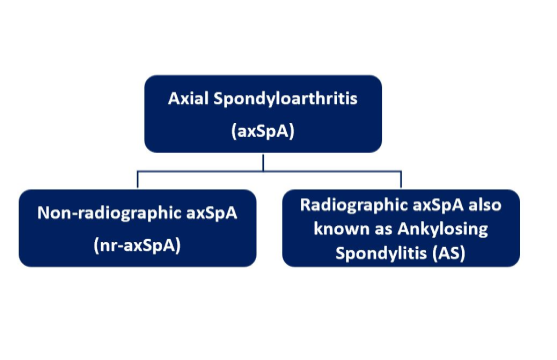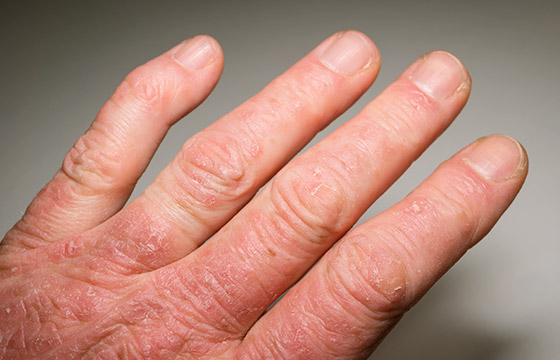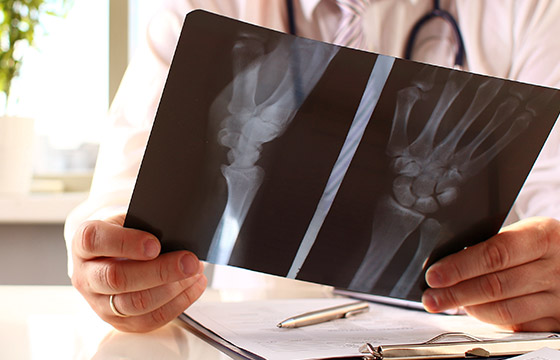Axial Spondyloarthritis and Ankylosing Spondylitis


Axial spondyloarthritis (axSpA) is an umbrella term for non-radiographic axSpA (nr-axSpA) and radiographic axSpA, also known as Ankylosing Spondylitis (AS). nr-axSpA and AS are closely related rheumatic conditions, both forms of inflammatory arthritis.
axSpA causes several parts of the lower spine to become inflamed, including the bones in the spine (vertebrae), spinal joints (sacroiliac joints) and other areas of the body. Over time, this can damage the spine and lead to the growth of new bone, which in some cases can cause parts of the spine to join up (fuse) and lose flexibility. This is known as ankylosis.
For people with AS, changes to the sacroiliac joints or spine can be seen on x-ray scans. However, for people with nr-axSpA these changes are not visible on x-ray, but inflammation may be visible on MRI (magnetic resonance imaging).
axSpA symptoms
axSpA symptoms can vary from person to person and usually develop over several months or years. axSpA can develop at any time but usually begins to develop in teenagers and young adults. The symptoms can come and go and may even change over time.
Almost all cases of axial spondyloarthritis are characterised by acute, painful episodes (flares), which are followed by periods when symptoms improve (remission).
The main symptoms of axial spondyloarthritis are:
Back pain and stiffness in the lower spine


Back pain and stiffness (inflammatory back pain) are usually the main symptoms of axial spondyloarthritis. The pain and stiffness, usually worse in the morning and at night, will normally improve with exercise and isn’t relieved by rest.
Other joint pain


axSpA can cause inflammation in other joints, most common are the hips, knees, ankles and shoulders. Affected joints can become painful, stiff and swollen.
Uveitis


Signs of uveitis are painful, watery or red eyes, blurred vision and sensitivity to bright light.
Enthesitis


A painful inflammation where bones attach to ligaments or tendons. Common sites include the top of the shin bone, behind or under the heel and where the ribs join the breastbone. If your ribs are affected, you may experience chest pain and find it hard to breathe deeply.
Other axSpA symptoms
Some people with axial spondyloarthritis can experience a range of more general symptoms, like:
- Feeling better after exercise and worse after rest
- Tiredness and a lack of energy (fatigue)
- A high temperature (fever)
- Sweating
- Depression
- Psoriasis (irritated, scaly patches of inflamed skin)
- Weight loss, especially in the early stages
- Bowel inflammation (which may be associated with Crohn's disease or ulcerative colitis)
- Dactylitis (swollen fingers and toes)
What causes axSpA?


It's not yet known what causes axSpA, but there seems to be a link with a particular gene known as human leukocyte antigen B27 (HLA-B27).
Research has discovered that roughly 9 out of 10 people with axSpA carry the HLA-B27 gene. However, having the gene doesn’t necessarily mean you’ll develop axSpA, as it’s thought that the gene may make you more vulnerable to developing the condition.
axSpA may be triggered by one or more environmental factors, although it’s not known what these are. Environmental factors can be many things, such as a virus, infection, trauma of some kind, or having a very stressful event in your life like childbirth or bereavement.
Can axial spondyloarthritis be inherited?
Axial spondyloarthritis can run in families and the HLA-B27 gene can be passed on (inherited) from another family member. If you have a close relative who has axial spondyloarthritis , such as a parent or a sibling (brother or sister), you are three times more likely to develop the condition compared to someone who does not have a relative with the condition.
If you have axial spondyloarthritis and the HLA-B27 gene, there is a 50% chance that you may pass on the gene to any children you have. It’s estimated that between 5% and 20% of children with this gene will then go on to develop axial spondyloarthritis. If you have axial spondyloarthritis but don't carry the HLA-B27 gene, the chance of any children you have developing the condition is less than 10%.
Read more

Psoriatic Arthritis
Psoriatic arthritis is a condition where arthritis and psoriasis occur together
Read more
Rheumatoid Arthritis
Rheumatoid arthritis is a painful condition caused by inflammation of the joints
Read more
Diagnosing Inflammatory Arthritis
Your doctor will use several scans and tests to diagnose inflammatory arthritis
Read moreSend your Feedback!
Would you recommend the UCBCares website to other visitors?